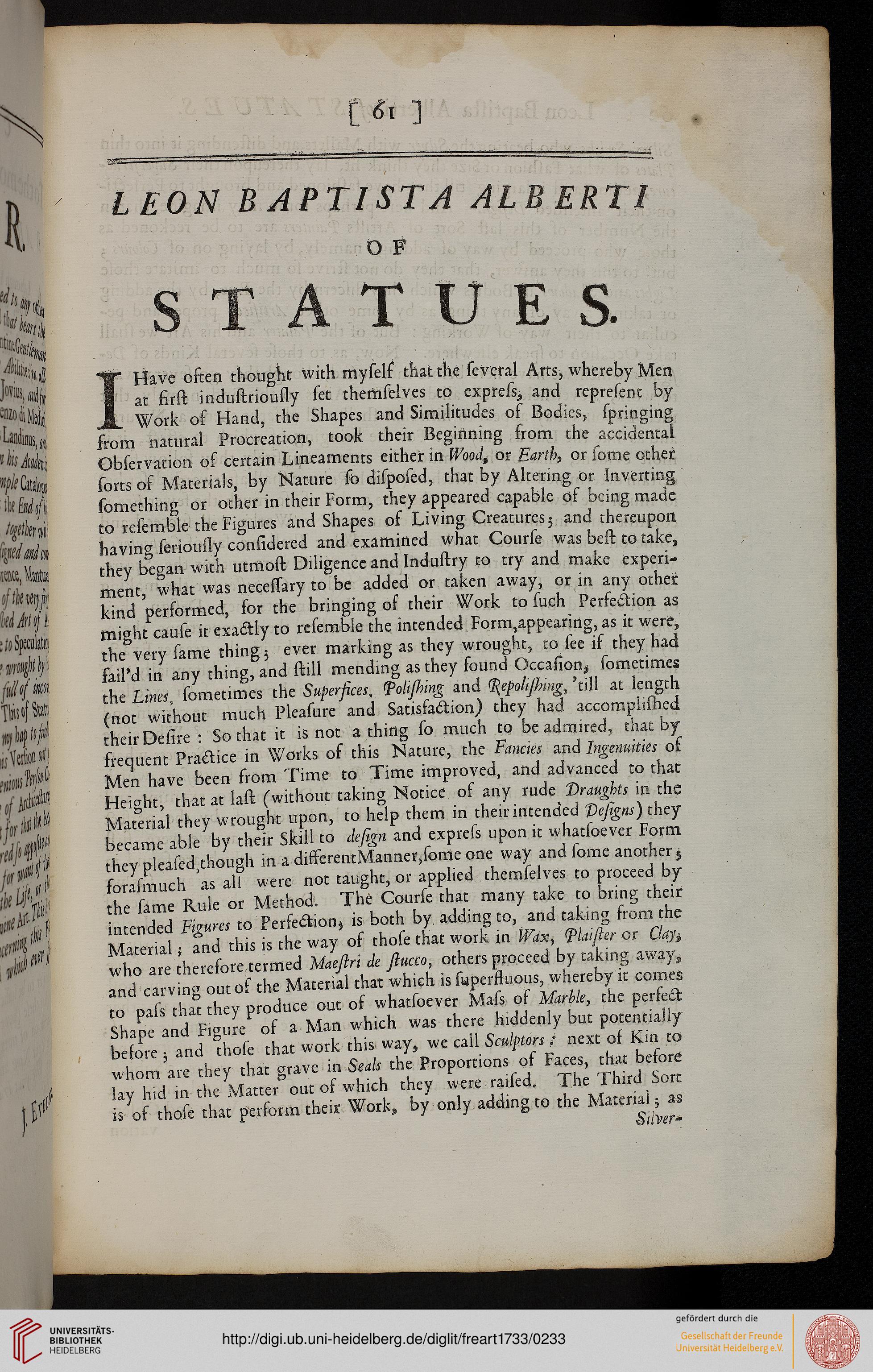C ^ ]
Y1 ii r mi
££OiV BAPTISTA ALBERT!
O F
TUES.
IHave osten thought with mysels that the several Arts, whereby Men
at firft induftrioufly fet themfelves to exprefs, and reprefent by
Work os Hand, the Shapes and Similitudes of Bodies, fpringing
from natural Procreation, took their Beginning srom the accidental
Obfervation os certain Lineaments either in Wood, or Earthy or fome other
forts of Materials, by Nature fb difpofed, that by Altering or inverting
fomething or other in their Form, they appeared capable of being made
to resemble the Figures and Shapes of Living Creatures 5 and thereupon
having ferioussy confidered and examined what Courfe was beft to take,
they began with utmoft Diligence and Induftry to try and make experi-
ment, what was neceffary to be added or taken away, or in any other
kind performed, sor the bringing of their Work to fueh Persection as
might cause it exactly to resemble the intended Form}appearing, as it were,
the very same thing $ ever marking as they wrought, to fee is they had
fail'd in any thing, and ftill mending as they found Gccasion^ sometimes
the Lines^ sometimes the Superfices, Tolisbing and <%epolijhmg, 'till at length
(not without much Pleasure and Satissaction) they had accomplished
their Desire : So that it is not a thing so much to beadmired3 that by
frequent Practice in Works os this Nature, the Fancies and Ingenuities os
Men have been from Time to Time improved, and advanced to that
Height, that at laft (without taking Notice of any rude Draughts in the
Material they wrought upon, to help them in their intended Dejlgns) they
became able by their Skill to defign and exprefs upon it whatsoever Form
they pleased3though in a differentManner5some one way and fome another 5
sorafmuch as ali were not taught, or applied themselves to proceed by
the fame Rule or Method. The Course that many take to bring their
intended Figures to Persection* is both by adding to, and taking from the
Material; and this is the way of thofe that work in Wax, (plainer or Clay*
who are therefore termed Maeftri de ssucco, others proceed by taking away^
and carving out of the Material that which is superfluous, whereby it comes
to pafs that they produce out os whatsoever Mafs of Marble, the perfect
Shape and Figure of a Man which was there hiddenly but potentially
besore \ and thofe that work this way, we call Sculptors / next of Kin to
whom are they that grave in Seals the Proportions of Faces, that before;
lay hid in the Matter out of which they were raifed. The Third Sort
is of thofe that persorm their Work, by only adding to the Material 3 as
Sihtef*
Y1 ii r mi
££OiV BAPTISTA ALBERT!
O F
TUES.
IHave osten thought with mysels that the several Arts, whereby Men
at firft induftrioufly fet themfelves to exprefs, and reprefent by
Work os Hand, the Shapes and Similitudes of Bodies, fpringing
from natural Procreation, took their Beginning srom the accidental
Obfervation os certain Lineaments either in Wood, or Earthy or fome other
forts of Materials, by Nature fb difpofed, that by Altering or inverting
fomething or other in their Form, they appeared capable of being made
to resemble the Figures and Shapes of Living Creatures 5 and thereupon
having ferioussy confidered and examined what Courfe was beft to take,
they began with utmoft Diligence and Induftry to try and make experi-
ment, what was neceffary to be added or taken away, or in any other
kind performed, sor the bringing of their Work to fueh Persection as
might cause it exactly to resemble the intended Form}appearing, as it were,
the very same thing $ ever marking as they wrought, to fee is they had
fail'd in any thing, and ftill mending as they found Gccasion^ sometimes
the Lines^ sometimes the Superfices, Tolisbing and <%epolijhmg, 'till at length
(not without much Pleasure and Satissaction) they had accomplished
their Desire : So that it is not a thing so much to beadmired3 that by
frequent Practice in Works os this Nature, the Fancies and Ingenuities os
Men have been from Time to Time improved, and advanced to that
Height, that at laft (without taking Notice of any rude Draughts in the
Material they wrought upon, to help them in their intended Dejlgns) they
became able by their Skill to defign and exprefs upon it whatsoever Form
they pleased3though in a differentManner5some one way and fome another 5
sorafmuch as ali were not taught, or applied themselves to proceed by
the fame Rule or Method. The Course that many take to bring their
intended Figures to Persection* is both by adding to, and taking from the
Material; and this is the way of thofe that work in Wax, (plainer or Clay*
who are therefore termed Maeftri de ssucco, others proceed by taking away^
and carving out of the Material that which is superfluous, whereby it comes
to pafs that they produce out os whatsoever Mafs of Marble, the perfect
Shape and Figure of a Man which was there hiddenly but potentially
besore \ and thofe that work this way, we call Sculptors / next of Kin to
whom are they that grave in Seals the Proportions of Faces, that before;
lay hid in the Matter out of which they were raifed. The Third Sort
is of thofe that persorm their Work, by only adding to the Material 3 as
Sihtef*




